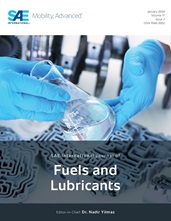Effects of Premixed Ratio on Engine Operation Range and Emissions of a Reactivity Controlled Compression Ignition Engine
- Features
- Content
- Strict measures in emission regulations constantly lead researchers to technologies that are cleaner, renewable, and energy conversion efficient. Reactivity controlled compression ignition (RCCI), which is a low-temperature combustion (LTC) mode, is a promising technology providing simultaneously low nitrogen oxides (NOx) and soot emissions without reduction in engine thermal efficiency. However, the fact that the operating range is still not wide enough compared to conventional engines is one of the most challenging obstacles to RCCI engines. In this study the effects of the premixed ratio (PR) on engine operating range and emissions were investigated experimentally. A compression ignition (CI) engine was modified to be run in RCCI mode. Gasoline and diesel fuels were used as fuel pair in the experiments. The engine was operated at three different PRs of PR25, PR50, and PR75. It was found that the widest operating ranges and minimum brake specific fuel consumption (BSFC) values were obtained with PR50. The minimum BSFC was 162.5 g/kWh. It was determined that HC emissions increased as the PR increased due to the decreasing reactivity of the mixture. It was also found that CO emissions are more sensitive to engine load compared to the PR.
- Pages
- 11
- Citation
- Şahin, F., Halis, S., Yıldırım, E., Altın, M. et al., "Effects of Premixed Ratio on Engine Operation Range and Emissions of a Reactivity Controlled Compression Ignition Engine," SAE Int. J. Fuels Lubr. 16(2):169-179, 2023, https://doi.org/10.4271/04-16-02-0013.
